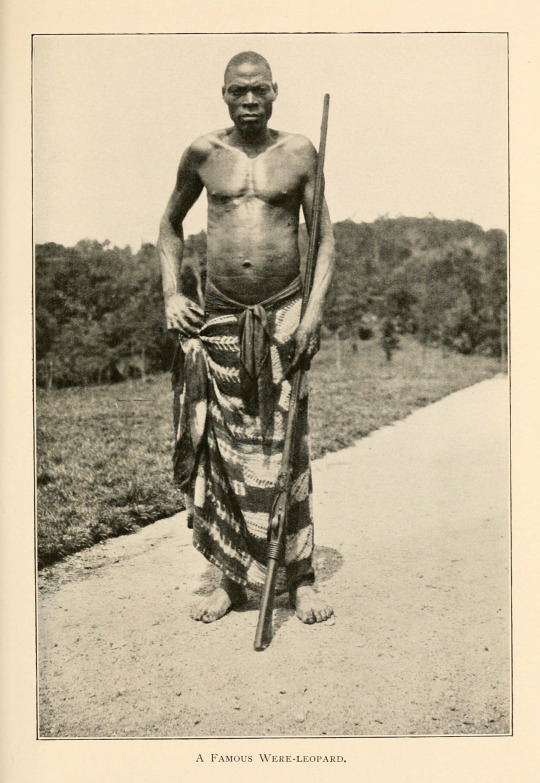Historical images of the Igbo, their neighbours and beyond. Blogger / Twitter / Instagram: @ukpuru
Don't wanna be here? Send us removal request.
Photo

Igbo compound (ǹgwùlù) entrance and high walls (aja ǹgwùlù), in or near Önïcha. Photographed by Herbert Wimberley, c. 1903-18. Cambridge University Library.
338 notes
·
View notes
Photo

Ohafia women with long braids fashionable in Ohafia at the time. Photographed by Rev. William T. Weir. From The Women's Missionary Magazine of the United Free Church of Scotland, 1904. Google digitisation.
The Story of Dike Nwaàmị̀: Women Warriors of Ohafia [main Ụ́kpụ́rụ́ blog].
228 notes
·
View notes
Photo

An Igbo compound entrance, in or near Önïcha. Photographed by Herbert Wimberley, c. 1903-18. Cambridge University Library.
180 notes
·
View notes
Photo

"A Famous Were-Leopard". Percy Amaury Talbot. Internet Archive.
The power of metamorphosis is generally termed Uworraw-Ukponn, corresponding to the Ibo word Ehihi, and is sometimes inherited, sometimes bought. […] Usually fast runners, and those who move with a peculiar creeping motion, are looked upon as leopard souls[.]
– Percy Amaury Talbot (1923). Life in Southern Nigeria. pp. 88, 106.
Many communities and lineages among Cross River peoples like the Ibibio and among different Igbo groups and beyond have special animals or vegetation that they have bonded with. In many cases, this came with the ability to take the form of the animal, plants, or trees through a projection of the individual's consciousness which can happen at great distances such as from one's home to an entity in the wild. The ability is usually first gotten through medicine and is hereditary. Sometimes these animals may have protected or saved the community before the bond. It is forbidden for members of such lineages to harm or harvest the animals, plants, or trees they have bonded with or allow others to do so because they are considered kin.
263 notes
·
View notes
Photo

An Igbo woman from Nibo, present-day Anambra State. Photographed by Northcote Thomas c. 1911. MAA Cambridge.
500 notes
·
View notes
Photo

An Igbo girl from Nibo, present-day Anambra State, with ùlì designs on her skin. Photographed by Northcote Thomas c. 1911. MAA Cambridge.
441 notes
·
View notes
Photo

Double edged sword with a fluted blade from Arochukwu in the eastern Igbo area, c. 1932 or earlier. Pitt Rivers Museum.
107 notes
·
View notes
Photo

A woman with crest hairstyle and ornaments, Igboland. Photo: Afrika Museum, Berg en Dal, Mid 20th century.
788 notes
·
View notes
Photo

Titled elder Onyeso of Agukwu Nri washing hands for a rite before a shrine to Agwụ̀, a divinity of doctors (dibị̀à). Photographed by Northcote Thomas in 1911. MAA Cambridge. Agwụ̀ is an entity of unconventionality and hence creativity that guides the dibị̀à. Agwụ̀ is related to strange occurrences and mishaps. Such occurrences are often signs to individuals that are destined to become doctors.
218 notes
·
View notes
Photo

‘Stereoscopic’ gif made from two photos taken in succession of an Igbo man from Öka (Awka) by Northcote Thomas c. 1910-11.
768 notes
·
View notes
Photo

25 July 1905. Uduk-Usaw. Boy.
Charles Partridge, in what is now Akwa Ibom State, Nigeria.
361 notes
·
View notes
Photo

COMIC MASK FROM LUGHULU MASKERADE. ITEM TRIBE, ISU-ITEM I[G]BO
240 notes
·
View notes
Photo

Ekpe (leopard society) meeting house
View of Ekpe meeting house in Umuajatta village, Olokoro near Umuahia. The house has a tall thatched roof and a wall painted by an Annang artist in the style of the Ngwomo ghost houses.
328 notes
·
View notes
Photo

IGBO “juju” figure called ARIOKU. brought out from hut shrine. “If a man swears falsely he is killed by ARIOKU”. c.5ft.10 inches high. Ichi scarification, mouth, + hands painted red. Old cornelian bead + feathers suspended on chest iron ring in rt. hand, red + yellow camwood powder on hands. near INYEOGUGU, ½ hrs. drive (? 20 miles) from OWERRI. 1/3/46., One of a group of 4 tall figs, 1 small fig., and one IKENGA figure.“
— William Fagg, 1 March 1946
111 notes
·
View notes
Photo

Sobo [Urhobo or Isoko] dancers from Warri with locked hair. 1880-1905, Unknown photographer.
246 notes
·
View notes
Photo

A washing pool in Calabar. Photo taken at the turn of the 20th century. Manuel Menedez.
74 notes
·
View notes
Photo

Sword sheath found in Liberia in 1860s with “Old Calabar” written with ink. British Museum.
62 notes
·
View notes